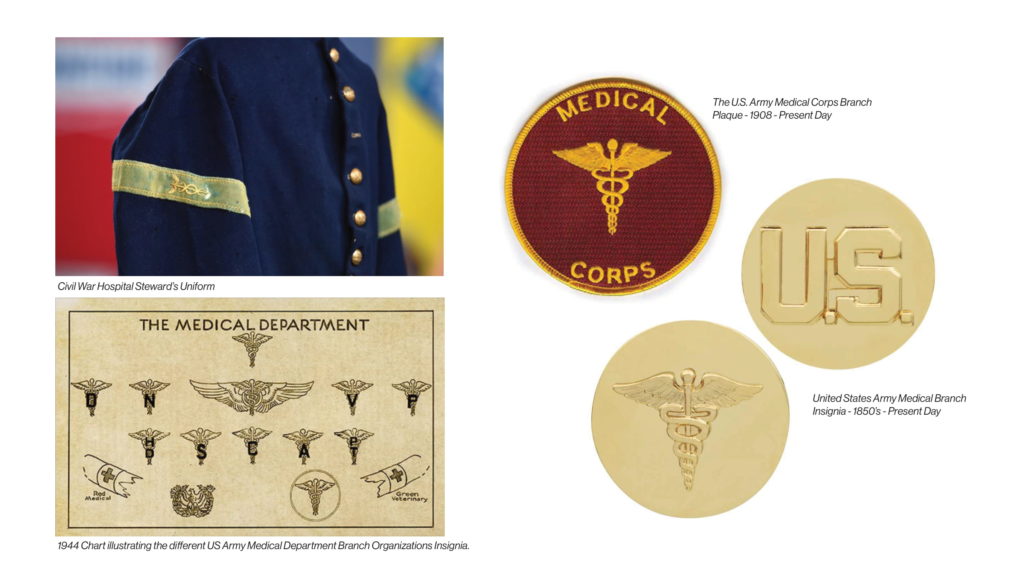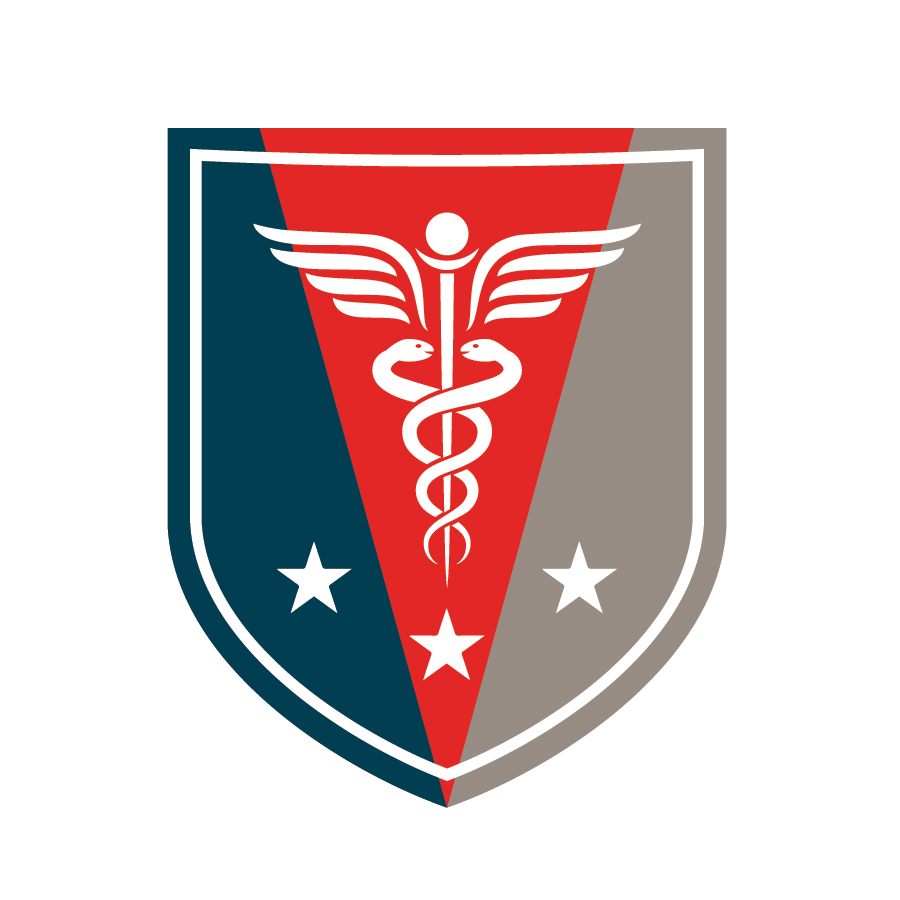Table of Contents
The Caduceus versus the Rod of Asclepius
David Price and Terry Reimer
The process of rebranding for the National Museum of Civil War Medicine (NMCWM) was long, purposeful and methodic. We knew from the beginning that not everyone, everywhere would be happy with the result. The universal belief among our staff and stakeholders was that the main source of contention in our logo would be the presence or absence of the Confederate flag (whichever Confederate flag design is your favorite). As the process unfolded and more than 100 designs were considered it became clear that neither flag would be included. We made sure that fact was communicated publicly during the process and it gave people time to express their opinions both positively and negatively.
We narrowed down the final design options to eight layouts; all were shields in various sizes and color schemes, all included stars and all included either the Caduceus or the Rod of Asclepius. We were extremely surprised to discover that the most heated and vocal debate occurred over the choice to use either the Caduceus or the Rod of Asclepius to represent Civil War medicine. Strong opinions and statements were made in staff meetings and subsequent board meetings that followed regarding which symbol was historically correct and which truly represented medicine. These discussions lasted over several weeks.

Terry Reimer, our Director of Research for the last 20 years, provided the following information for background and historical purposes.
The Caduceus has two snakes intertwined around a staff, with two outstretched wings at the top. The Rod of Aesculapius (latin spelling) has a single snake intertwined with a rough branch, and no wings. The Caduceus was originally the symbol of the Greek messenger god, Hermes, known as Mercury by the Romans. This symbol has long been associated with non-combatants and with heralds and messengers. Aesculapius was the Greco-Roman god of medicine, a son of Apollo. He is usually depicted with a walking stick entwined with a single serpent.
While the Rod of Aesculapius would appear to be the logical choice for the symbol of medicine, in military medicine both the Rod of Aesculapius and the Caduceus are used, mainly because medical personnel are considered non-combatants during conflicts. The two symbols were not necessarily interchangeable, but both came to represent the medical service.
The original coat of arms for the U.S. Hospital Department, established in 1818, included the Rod of Aesculapius, twenty stars, thirteen stripes, and a rooster. In 1856, the Caduceus was first used on the arm chevron worn by Hospital Stewards and stretcher bearers to indicate their non-combatant status. This symbol was used throughout the Civil War for Hospital Stewards. Many Surgeons and Assistant Surgeons were identified by an embroidered “M.S.” on the hat or shoulder strap, and by a green sash.

After the Civil War, the U.S. Public Health Service adopted the Caduceus as their symbol in 1871. By 1881, the Caduceus was being used in a limited capacity by the U.S. Army Hospital Corps. It was not until 1902 that the Caduceus was formally adopted as the insignia of both enlisted men and officers of the U.S. Medical Corps. It is thought the Caduceus was meant to indicate the role of the corps as non-combatants rather than to represent the medical role, but no explanation for this choice was ever given.
So, while the Rod of Aesculapius may be the more appropriate medical symbol, our country’s own Medical Department uses the Caduceus, and it has become synonymous with medicine in the eyes of the general public. While it began as a symbol for non-combatants, it has developed into a general symbol for medical caregivers.

The new National Museum of Civil War Medicine logo could have contained either the Rod of Asclepius or the Caduceus and been on solid historical ground. Several factors made the choice for the Caduceus clear.
- The fact that the Caduceus was used on the arm bands of hospital stewards (several of which are in our collection) and is actually present in our ambulance gallery on the arm band of a stretcher bearer was first and foremost.
- The rebranding study was initiated because our story has expanded exponentially from being solely focused on the story of battlefield medicine. Our story as told through three unique museums, our social media and outreach now includes the civilian impact of war, the role of all non-combatants (specifically nurses like Clara Barton), the foundation of mass casualty relief and the treatment of refugee populations from a medical, hygiene and nutrition viewpoint.
- The images of the two snakes facing each other, entwined around the rod could easily be representative of the North and the South in conflict, but united around medicine.
- The image of the wings stretching out from that conflict and compassion denotes the incredible advances of medicine that arose out of the bloody Civil War.
- The shape of the Caduceus and the size of the design makes medicine the focal point and is more symmetrical and thus more pleasing to the eye than the options with the Rod of Asclepius.
Within a matter of months the new logo will be instantly recognizable as the symbol for the National Museum of Civil War Medicine and our 3 locations. We acknowledge that change is hard. We hope that even if you disagree with our choice, you will acknowledge that much thought, care, and time was dedicated to this process.
About the Authors
David Price has been the Executive Director of the NMCWM since 2015. Mr. Price joined the NMCWM in 2011 as Director of Strategic Initiatives and was quickly promoted to Chief of Operations in 2013. Prior to joining the NMCWM, Mr. Price spent 12 years as the Marketing Manager for country music artist Waylon Jennings, was a writer/producer for Jim Owens Television Productions where he wrote more daily show scripts than he can count, directed several music videos and produced national television segments from locations across the country. He has travelled the continental United States three times over.
Mr. Price has served in local government as an elected official, is a member of the National Civil War Museum Advisory Board, Heart of the Civil War Heritage Area Advisory Board, serves on the Board of Tourism for Frederick, Maryland and is member of the Cultural Leaders of Washington DC.
Terry Reimer is presently the Director of Research the National Museum of Civil War Medicine in Frederick, Maryland. Previous work includes over twenty years of experience in historical archaeology and research, specializing in 17th, 18th and 19th century American sites. TaShe holds a B.A. in Anthropology from the University of Maryland and did graduate work in anthropology and folklore studies at George Washington University. She is the author of three books, One Vast Hospital: the Civil War Hospital Sites in Frederick, Maryland after Antietam, Divided by Conflict, United by Compassion: The National Museum of Civil War Medicine, and The Story of Civil War Medicine: Divided By Conflict, United By Compassion. She is also the co-author of two other books, Bad Doctors: Military Justice Proceedings Against 622 Civil War Surgeons and Caleb Dorsey Baer: Frederick, Maryland’s Confederate Surgeon.
Want to learn more? Follow us on Facebook and Twitter to discover more stories from Civil War medicine!
Become a museum member and support our educational programs and research like this.


